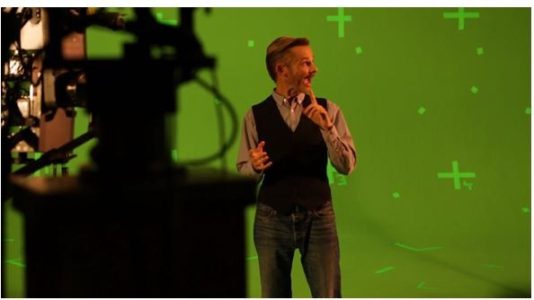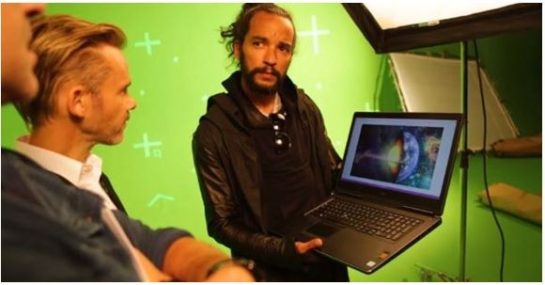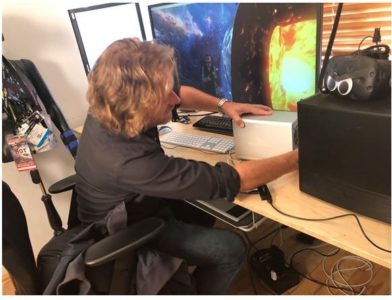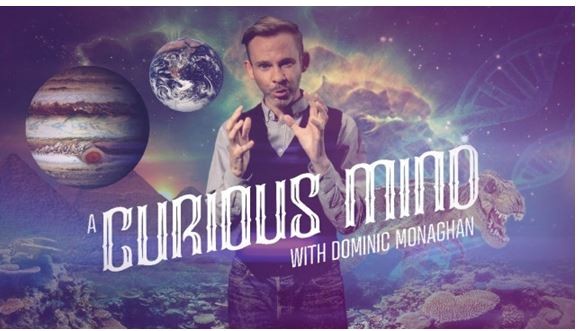
While Hulu is best known for its mainstream, award-winning series like The Handmaid’s Tale, the streaming media firm had an early interest in taking viewers inside their content with VR (virtual reality). Beating Netflix to market with a VR app, Hulu now has a rapidly growing library of VR shows.
The recently released project, A Curious Mind, takes viewers deep inside the science that created our universe; thanks to the host, Dominic Monaghan (Lord of the Rings, Lost, X-Men Origins), and the creative work of Toronto-based Cream VR that has co-produced a number of immersive projects for Hulu.
A Curious Mind evolved over several years, when 360 and VR were just in its infancy.
Cream’s CEO David Brady wanted to do an immersive series in the style of Carl Sagan’s highly popular Cosmos: A Space Odyssey, but one that would enable viewers to get up close and personal with the topics rather than just merely being passive viewers.

The Camera’s Eye – Dominic Monaghan, Curious Mind’s emcee, was shot on green screen and composited into the final 360° environment.
Cream had the perfect host. “We had worked with Dominic in the past on Wild Things, a series for Travel channel,” said Andrew MacDonald, Cream VR creative director. “In that series, we went to exotic and remote areas to explore nature and wildlife; and in the last season, created VR ancillary content to accompany the show.
“He was curious about everything, everywhere we went,” MacDonald recalled. “He has an infectious interest in learning new things and sharing that knowledge with the audience. People loved it and really got into being involved in the segments, exploring and finding new things every time they put on their HMDs (head-mounted displays) and tuned in to Wild Things.”
Microsoft jumped in to sponsor the new A Curious Mind production to be released exclusively in their new MR headset through the HuluVR app.
Until A Curious Mind, MacDonald and creative director, Tristan Cezair had focused on narrative projects that required many subtle creative moves (audio and visual) to keep the viewer focused on the project’s primary POI (point of interest).
“The strength and weakness of the immersive content is that the viewer is ‘involved’ MacDonald said. “Creatively, we need to control the viewing to tell the complete story.“The user can physically participate in the story telling and shape the experience simply by looking away from the POI. Our challenge was to guide him or her so Dominic and the viewer both arrive at the conclusion at the same time.”
With Dominic as the emcee/guide for the show, it was easier for the creative team to help viewers transition from one scene to another and make sense of the story.

Space Shot – Dominic Monoghan takes 360-degree viewers beyond the bounds of earth to explain the breakdown of the atmospheres that surround the globe.
In the show, Dominic is the viewer’s guide as both explore mind-bending scientific concepts and the “big ideas” of the universe. In A Curious Mind, Dominic and the viewer make the journey together; manipulating time and space, pulling apart atoms and exploring/experiencing science as never before.
For A Curious Mind, MacDonald and Cezair used multiple Blackmagic micro studio cameras with Luminex 8mm lenses to capture Dominic and his “exploration” in front of a green screen. 360 degree set extensions and assets were added in post.
The challenge was to shoot the subject with a moving camera in stereo against a green screen, close but with an ultra-wide angle and then motion track the footage so it could be placed in 360 3D 8K set extensions.

Shoot, Review – Tristan Cezair, creative director at Cream VR, checks some of the early rendering work done for Curious Minds with Dominic Monoghan, emcee for the series. A seasoned professional, Monoghan has appeared in a number of films including The Lord of the Rings.
“We needed to capture him at a very high resolution/pixel density across nearly 100 percent of the camera’s sensors, which the Luminex lenses enabled us to do,” MacDonald explained. “But it also created a problem because we had to reduce the FOV (field of view) to be close enough to Dominic while still capturing his entire body from a natural eye level.”
To deliver viewer comfort, the Cream VR team shot from slightly above Dominic, tilting the camera backward to capture his full body and the surrounding scene that would be added.
Since the footage was shot downward, it meant extra work for the Cream VR team when they composited the moving camera shots into the CGI (computer-graphics imagery) footage.
“We used to think nothing of saying we’ll fix it in post,” MacDonald said, “but when it comes to producing a complex series of shows like A Curious Mind post can be an expensive and time-consuming process and you have to minimize both budgets.”
To deliver the best viewer involved entertainment, Cream VR used a combination of Adobe Premiere Pro, After Effects, Mettle SkyBox 360/VR plugins, Canvas 360, and beta versions of Maxon’s software. The result provides viewers with a “natural” view by rendering footage so that it is viewed perfectly horizontal.

Prep Work – Cream VR’s creative director, Andrew MacDonald, connects one of the firm’s OWC Mercury Elite Pro Qx2 units to refine some of the stitching on the first segment of Curious Minds, a 360 production for Hulu.
Between the shooting of a 7-1/2-minute segment and the CGI footage, Cream VR had generated more than 18 TB of data on OWC ThunderBay 4 RAID storage units.
“We’ve been relying on the ThunderBay 4 storage systems since the beginning,” MacDonald noted. “We needed the reliable upload/download speeds that Thunderbolt provides in combination with the ultra-quiet, reliable performance the OWC units provide and the fact that we can configure the RAID protection/performance to meet our project needs.”
To do the rendering of the project, Cream VR needed more computing power than they had in-house.
“We’re talking about 8K footage with lots of layered heavy effects applied to it,” MacDonald emphasized. “Studios simply can’t afford to have that much expensive, big-iron sitting around waiting for you to use it.”
In addition, for A Curious Mind, Hulu wanted to deliver the viewer complete ambisonic audio, which was provided by audio specialists who spatialized the music and added subtle complimentary surround sound.

Grinding Away – 300-lb servers from SIRT took 2 weeks to render a 7-1/2 minute 8K file layered with lots of effects.
To solve the complex rendering process, the Cream VR team contacted the Canadian-funded Sheridan SIRT (Screen Industry Research and Training Centre) in Toronto which provides fiber optic networks to connect post production houses in the city to a cloud rendering solution.
After some negotiations, SIRT provided Cream VR with three racks of high-performance Dell blade servers.
Turning from creatives to IT techs, MacDonald and Cezair installed the systems in a makeshift server room minus the cooling and soundproofing running off a conventional 70-amp stove plug.
“It sounded like a jet engine when we turned everything on,” MacDonald said grinning. “Even with using 48 nodes in the render farm, it took about 14 days (running day/night) to render the complete 7-1/2-minute project.”
Available on HuluVR, the 360 3D segments give viewers the opportunity to explore science and the universe as never before.

“With actors like Dominic and the lead that Hulu is providing, we – and by that, I mean the professional VR filmmakers – really are bringing the technology into every day personalized entertainment,” said MacDonald.
# # #

